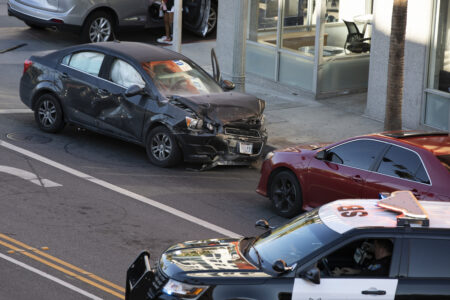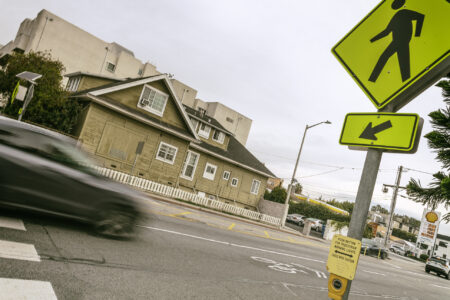
Share On Social!
Thanks to vaccinations, antibiotics, and medical treatment, death from infectious disease has declined drastically among children in high-income countries.
But violent death is a serious threat to children in the United States.
Here, guns and traffic crashes are the top killers of youth aged 1-19.
Worse, these violent child deaths have increased in recent years.
We can’t explain away all traffic crashes on individual behavior. We also can’t explain away all firearm incidents on individual behavior.
These are systemic problems that require systemic solutions.
Salud America! is exploring the scope of violent child death as part of its four-part series on public health approaches to addressing child deaths from guns and traffic crashes.
The State of Child Traffic Deaths
The traffic death rate declined consistently since 1975 to 2010 due in large part to federal vehicle safety regulations, like seat belts. We will explain more about why in the second post in this series coming out September 15.
However, the decline stalled from 2010 to 2019.
Now traffic deaths spiked 24.5% from 2019 to 2020 and another 10.5% from 2020 to 2021.
Traffic death rates are now much higher in the U.S. (12.4 per 100,000) than Australia (5.6), Canada (5.8), Spain (4.1), and Sweden (2.8), according to the World Health Organization (WHO) 2018 global status report on road safety.
But how do children fare in these overall numbers?
For decades, traffic crashes have been the leading cause of death for toddlers, children, and youth aged 1-19. In 2016, over 4,000 children and youth ages 1-19 were killed in motor vehicle crashes, according to a 2018 special report in the New England Journal of Medicine.
Among children younger than 1, child traffic deaths per million increased from 11.9 in 2014 to 14.2 in 2020, according to the Insurance Institute for Highway Safety (IIHS). Similarly, among children ages 9-12, child traffic deaths per million increased from 9.7 in 2012 to 11.4 in 2020.
In 2019, 17% of children younger than 13 that were killed in traffic crashes were killed while walking, according to the most recent Traffic Safety Facts using 2019 data from the National Highway Traffic Safety Administration (NHTSA).
It is worse for very young children walking.
In 2020, 26% of traffic deaths among children ages 1-3 were children walking, according to IIHS.
Of children walking who were killed by people driving, 73% occurred in urban areas and 56% occurred during daylight, according to Traffic Safety Facts.
Of children biking who were killed by people driving, 75% occurred in urban areas and 88% occurred during daylight
Between 65% and 92% of these children were wearing helmets when killed.
Of course, injuries are also a major problem.
In 2019, 183,000 children age 14 and younger were injured in traffic crashes, according to the most recent Traffic Safety Facts using 2019 data from the National Highway Traffic Safety Administration (NHTSA).
Although NHTSA has not yet released the latest Traffic Safety Facts, preliminary analysis has revealed that 12.5% more children younger than 16 died in traffic crashes in 2021 than 2019.
The rise in traffic deaths overall and among children specifically is happening at the same time as a rise in traffic fatalities involving newer vehicles than older vehicles.
Newer vehicles (≤10 years) accounted a larger share of the increased fatalities than older vehicles with 16.5% more fatalities in newer vehicles in 2021 than 2019 compared to 10.3% more fatalities in older vehicles in 2021 than 2019, according to NHTSA’s Traffic Safety Facts.
In 2011, the AAA Foundation for Traffic Safety analyzed the risk of severe injury and death in relation to impact speed of a forward-moving car or light truck.
However, their analysis was based on vehicle models between the years 1989 and 1999.
This is a problem because the size and weight and vehicles has increased drastically since then, spurring an underestimation of the risk of injury and death due to impact speed and size
Although traffic crashes are still a major problem for American adults and children, traffic crashes are no longer the top cause of child violent deaths.
The State of Child Firearm Deaths
As of 2019, firearms now kill more children and youth than motor vehicle crashes, according to a 2022 special article from the American Academy of Pediatrics.
In 2020, 4,357 children ages 1-19 years were killed by guns.
Youth are disproportionately burdened by rising firearm death rates.
“From 2019 to 2020, the relative increase in the rate of firearm-related deaths of all types (suicide, homicide, unintentional, and undetermined) among children and adolescents was 29.5% — more than twice as high as the relative increase in the general population,” according to a 2022 letter to the editor in the New England Journal of Medicine.
“Guns killed more children and teens than cancer, pneumonia, influenza, asthma, HIV/AIDs, and opioids combined,” according to the gun violence prevention group Brady.
“Guns killed more preschoolers than law enforcement officers in the line of duty,” according to The State of America’s Children 2021: Gun Violence released by the Children’s Defense Fund.
Five children ages 1-17 were killed with guns in the U.S. every day, according to 2016 Brady data.
That number jumped to nine, according to 2019 data in The State of America’s Children 2021: Gun Violence from the Children’s Defense Fund.
Firearm deaths are much higher in the U.S. than other high-income countries.
The overall firearm death rate in the U.S. in 2010 was 10 times higher than other high-income countries, like Austria, Czech Republic, Ireland, and Japan, according to a study in the American Journal of Medicine.
The firearm death rate for American children ages 1-19 is 5.6 per 100,000 compared to 0.8 in Canada, 0.5 in France, and 0.3 in Belgium, according to a 2022 issue brief from Kaiser Family Foundation.
This isn’t a new problem, either.
In 2010, before the recent spike in traffic violence and gun violence, the firearm death rate for children ages 0-4 was 33.8 times higher in the U.S. than in other high-income countries in 2010, according to a 2010 study in the American Journal of Medicine.
“In 2019, firearm deaths accounted for 925,023 years of potential life lost before the age of 65 – more than diabetes, stroke, and liver disease combined,” according to The Educational Fund to Stop Gun Violence.
Beyond injuries and deaths from firearms and motor vehicles, American children are also subject to witnessing the violence from firearms and motor vehicles.
Although we have enough data to understand that violent child death is a problem in America, there are many different types of traffic violence and firearm violence that we do not fully understand.
We need better injury prevention research to identify and implement targeted strategies.
Social and Economic Toll of Traffic Crashes and Firearm Violence
Gun violence generates over $1 billion in direct health care costs every year for victims and their families, according to a 2021 report from the Government Accountability Office (GA). Beyond that, exposure to gun violence generates indirect health care costs due to mental and emotional harms, work lost, and decreased quality of life.
For example, gun violence negatively impacts education attainment, strains school and state budgets, reduces business growth, and slows housing price growth, according to a Joint Economic Committee report.
“School shootings increase absenteeism and grade repetition; reduce high school graduation, college enrollment, and college completion; and reduce employment and earnings at ages 24–26,” according to a 2020 white paper from the National Bureau of Economic Research (NBER).
In 2021, the education sector spent $3.1 billion on new security equipment.
That amount was to “harden” schools and does not include the hundreds of millions spent on the addition of armed law enforcement officers at school campuses.
Spending on the school security industry not only strains state budgets but also negatively impacts local economies.
“Gun violence hurts local economies by significantly reducing the growth of new businesses and the number of jobs these businesses provide,” the Joint Economic Committee report states. “Higher rates of gun violence can also have negative impacts on the housing market by affecting the perceived desirability of areas.”
The economic burden of gun violence is likely much higher than estimated due to lack of data collection.
For example, the estimates for the health care costs of gun violence are based on initial hospital treatment and short-term costs incurred in the first years after the incident from 2016-2017. They do not include long-term health care costs or physician’s costs, which could add around 20% to the total, according to the GAO report.
One study looking only at pediatric musculoskeletal firearm injuries in one pediatric trauma center over a 14-year period found that net revenues for the trauma center were almost negligible.
“[Children who sustain musculoskeletal injuries from firearms] have high rates of injury-related complications such as nerve and vascular injury,” the study states. “And the costs to the pediatric hospitals resulting from these injuries are considerable, especially patients with long hospitalizations and protracted clinical courses.”
When considering work lost and decreased quality of life in addition to total medical spending, in 2013, 74,072 firearm-related injuries (adults and children) cost $16.32 billion and more than 3 million traffic crash injuries (adults and children) cost $207 billion, according to Healthcare Finance.
It is clear that violent child death is a problem in America with lasting social and economic impacts.
However, certain children bear the brunt of the pain and death.
Inequities in Firearm Violence and Motor Vehicle Crashes
Gun violence has a disproportionate impact on urban communities of color.
For example, according Giffords 50 State Factsheets:
- In Arizona, Black and Hispanic men make up less than 17% the population, but account for more than 48% of the state’s gun homicide victims.
- In Colorado, Black and Hispanic men make up less than 13% of the population, but account for more than 47% of the state’s gun homicide victims.
- In Nevada, Black and Hispanic men make up just 18% of the population, but account for more than 51% of the state’s gun homicide victims.
- In New Mexico, Black and Hispanic men make up less than 24% of the population, but account for nearly 52% of the state’s gun homicide victims.
- In Texas, Black and Hispanic men make up less than 25% of the population, but account for nearly 63% of the state’s gun homicide victims.
- In Utah, Hispanic men make up less than 7% of the population, but account for nearly 23% of the state’s gun homicide victims.
“There’s a reason certain neighborhoods have much higher rates of gun violence,” said Daniel Webster at the Johns Hopkins Center for Gun Violence Solutions, part of the university’s Bloomberg School of Public Health, according to USA Today. “It has to do with disinvestment, the conditions within those neighborhoods, the lack of opportunities in those neighborhoods.”
Latino and Black Americans have higher traffic fatality rates per mile traveled than whites across the transportation system,
When accounting for miles traveled biking, walking, or driving, Latino and Black Americans have higher traffic fatality rates than whites, according to a new study in the American Journal of Preventive Medicine.
This study is unique in that it accounts for miles traveled per capita thus provides a more accurate estimate of inequities in traffic deaths than previous studies which do not account for miles traveled.
Regarding pedestrian deaths, Latinos (1.8 pedestrian deaths), Blacks (3.0 deaths), and American Indians or Alaska Natives (4.8 deaths) had higher pedestrian death rates per 100,000 population than Whites (1.5 deaths) from 2016-2020, according to the new Dangerous by Design report from Smart Growth America.
However, we do not know about inequities in child traffic deaths or inequities in serious injuries.
And there is still a lot more we do not know.
Inadequate Data Collection on Firearm Violence and Traffic Crashes
Safety starts with data.
Quality data is important to understand and make decisions about problems.
For example, according to NHTSA:
- Law enforcement use crash data to determine when and where to conduct data-driven enforcement.
- Highway safety offices use crash data to direct highway safety funding, evaluate programs, and develop strategic communication campaigns.
- Engineers use crash data to screen networks, diagnose trends, and select and prioritize countermeasures and evaluate implemented changes.
- Researchers use crash data to identify crash patterns and evaluate new countermeasures.
- Legislators use crash data to prioritize program implementation and draft new or modified data-driven legislation.
However, the U.S. lacks data on traffic crashes and firearm violence due to the lack of a public health approach to injury prevent and subsequent of lack of funding for injury prevention research.
Two reasons we lack data on firearm violence are due to Congress removing funding from the Centers for Disease Control and Prevention (CDC) for firearm injury research and due to Congress adding a provision to annual federal spending bills that prohibits the use of federal funds to advocate or promote gun control.
Why?
In 1993, the New England Journal of Medicine released a special article that, “rather than confer protection, guns kept in the home are associated with an increase in the risk of homicide by a family member or intimate acquaintance.”
“The [article] received considerable media attention, and the National Rifle Association (NRA) responded by campaigning for the elimination of the [the CDC’s National Center for Injury Prevention center] that had funded the study,” according to the American Psychological Association.
In response, pro-gun members in Congress added the Dickey Amendment to the appropriations legislation that funds the CDC and the National Institutes of Health (NIH) to prohibit the use of federal funds to advocate or promote gun safety.
The Dickey Amendment has been added every year since.
“Precisely what was or was not permitted under the clause was unclear,” according to the American Psychological Association. “But no federal employee was willing to risk his or her career or the agency’s funding to find out.”
Until 2018, this was interpreted as prohibiting federal funding of research on gun violence.
“Compared to other leading causes of death, far fewer research articles have been published on gun violence— leaving policymakers ignorant about many aspects of this crisis, and less capable of making policy decisions informed by rigorous research,” according to a gun violence fact sheet from Giffords Law Center.
Today, the federal government spends only $57 per gun death on research compared to $1,740 per heart disease death, $2,996 per cancer death, and $6,556 per lung disease death, according to a gun violence fact sheet from Giffords Law Center.
Can you imagine if the auto lobby and pro-auto-industry members of Congress were similarly successful in prohibiting the use of federal funds to research, advocate for, or promote traffic safety?
Traffic crash and fatality data is collected and maintained at the local, state, and national levels in a variety of databases; however, there is little in the way of federal legislation regarding the scope and extent of data collection.
“Every State—in cooperation with its local, regional, and Federal partners—should maintain a traffic records system that supports the data-driven, science-based decision-making necessary to identify problems; develop, deploy, and evaluate countermeasures; and efficiently allocate resources,” according to the National Highway Traffic Safety Administration (NHTSA) Traffic Records Program Assessment Advisory 2018 Edition.
Although states are required by law to develop a Strategic Highway Safety Plan that uses crash data to identify risk factors, there are few requirements regarding what crash data is collected.
“As part of its State highway safety improvement program, a State shall have in place a safety data system that can be used to perform analyses supporting the strategic and performance-based goals in the [Strategic Highway Safety Plan (SHSP)] and [Highway Safety Improvement Plan (HSIP)],” according to FHWA’s Guidance on State Safety Data Systems. “States are required to use their safety data systems to identify hazardous locations, sections, and elements that are a danger to all road users, including vehicle occupants and non-occupant users of the roadway (e.g., pedestrians and bicyclists), and to identify fatalities and serious injuries on all public roads by location.”
Per the 2015 Fixing America’s Surface Transportation Act (FAST Act), the Federal Highway Administration (FHWA) issued updated guidance to reflect changes related to State safety data systems under the Highway Safety Improvement Program (HSIP).
These requirements include 37 data elements from the Model Inventory of Roadway Elements (MIRE), known as Fundamental Data Elements (FDE), which provides a recommended guide of roadway characteristics and traffic inventory elements for states to consider for safety analyses.
However, none of these elements include posted/statutory speed limit, mean speed, 85th percentile speed, width of lanes, and presence/type of bicycle facility.
These are critical elements to identify hazardous locations.
Moreover, by only requiring certain Model Inventory of Roadway Elements (MIRE) data elements, States are not required to collect data on vehicle body type.
Although another national guideline on traffic crash data collection, the Model Minimum Uniform Crash Criteria (MMUCC), provides guidance for collecting data on vehicle body type, the MMUCC does not provide a distinction regarding the growing size of American SUVs and passenger trucks, known as “megacars.”
Insufficient requirements regarding traffic crash data collections results in an inadequate understanding about risk factors thus inadequate countermeasures.
Although, NHTSA developed the Crash Data Improvement Program (CDIP) to examine the quality of State’s crash data and provide States with guidance and recommendations to improve data to support safety decisions, if certain data elements are not required, they will not be captured in this process.
For example, the Crash Data Improvement Program (CDIP) includes the following six performance measures to assess State’s crash data: timeliness, accuracy, completeness, uniformity, integration, and accessibility.
“States need timely, accurate, complete, accessible, and uniform traffic records to identify and prioritize traffic safety issues and to choose appropriate safety countermeasures and evaluate their effectiveness,” according to the National Highway Traffic Safety Administration (NHTSA) 2017 Traffic Records Program Assessment Advisory.
However, accuracy and completeness can only be determined for existing data fields.
Edit checks cannot identify missing data for fields that aren’t required and don’t exist, resulting in gaps in data thus understanding.
More specifically, if data elements such as posted/statutory speed limit, mean speed, 85th percentile speed, width of lanes, and presence/type of bicycle facility that are not included in the State traffic records, then, these data are not collected.
Because these are not required data elements, an assessment of completeness will not flag that these data elements are incomplete.
“The ideal statewide system incorporates sufficient information on all public roads to support valid, system-wide network screening and countermeasure development, deployment, and evaluation,” according to Traffic Records Program Assessment Advisory 2018 Edition.
“Data gaps degrade our understanding of the places, people, vehicles, and contributing factors involved in crashes,” states the Traffic Records Program Assessment Advisory 2018 Edition.
“Systematic incompleteness is a serious threat to valid decision-making,” states the Traffic Records Program Assessment Advisory 2018 Edition.
Worse that insufficient data collection on traffic crashes, annual State safety performance targets are based on five-year rolling averages for the previous five years, rather than on objective targets.
Thus, rather than setting performance targets for zero fatalities, for example, states set performance targets for number of fatalities based on the number of fatalities during the previous five years.
“This is an aspirational exercise in agenda setting with no penalties whatsoever for falling short,” according to Angie Schmitt in STREETSBLOG USA.
In 2020, 31 states (60%) did not meet or make significant progress toward meeting safety performance targets that they established.
In the end, states can set goals for more people to die in traffic crashes, and if they come under those goals, it is considered a “success.”
Inadequate data collection on traffic crashes and rising safety performance targets are a threat to efforts to prevent violent child death and injury.
“It may not be possible to sustain the gains in traffic safety that have been made in the past, or to achieve further gains, without improvements in the quality and utility of these data,” according to a publication on Crash Records Systems from the Transportation Research Board.
Americans deserve more reliable data to understand the scope and complexity of traffic violence and gun violence.
We Need Better Injury Prevention Research
In the United States, guns and traffic crashes are the leading causes of death for youth aged 1-19.
Preventing violent child deaths from traffic crashes and firearms requires a comprehensive and multi-layered public health approach to:
- Define and monitor the problem
- Identify risk and protective factors
- Develop prevention strategies
- Ensure adoption of strategies
This is the first post in our series on addressing violent child death from this public health approach.
While it is clear that violent child death is a problem, it is also clear that we need better injury prevention research, particularly regarding violent child death and injury from motor vehicles and firearms.
Read the next post in the series about identifying risk and protective factors.
By The Numbers
27
percent
of Latinos rely on public transit (compared to 14% of whites).



